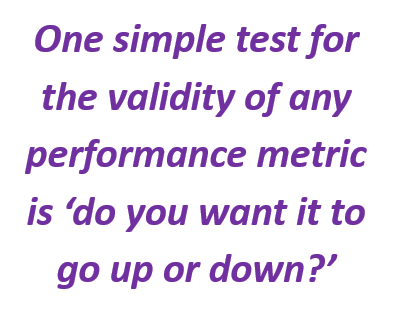 This is a true story.
This is a true story.
Many years ago, I was working with the training team at a manufacturing division of Motorola. They had just entered Q4 and I was there to teach them how to measure the value of training – for the company and its employees (see “How many ‘training hours’ should you have on your CV?’).
When I asked the trainers to provide me with a list of training already provided in the first three quarters, they laughed and said they hadn’t delivered any training. The COO had cancelled all training in Q1 because the plant was struggling to meet its production schedules. The same COO had only just remembered that one of his bonus objectives for that year was an ‘average of 5 days training, per employee’. ‘So what sort of training are you providing now?’ I asked; “whatever they want”, came the reply.
Any professional manager would be shocked by this story; if it were not for the fact they have become inured to such meaningless objectives and questionable bonus schemes. So is this just a minor aberration, around one pointless metric, or does it reveal something more insidious about the state of professional leadership and management and the perverse behaviours that are enforced?
All these years later, as Chair of the Maturity Institute (MI), I can say without any doubt that this single metric is the worst type of measure I can think of and it has inflicted untold damage on all organizations who use it. What I have also learned, from a maturity perspective, is that pointing the finger of blame will not remove this pernicious bit of data because it is a symptom of an underlying flaw in conventional management systems. While it remains in place it sends a clear signal that management doesn’t care; and management that doesn’t care is a dead profession. It is time we applied some simple but mature analysis to remedy this serious situation.
 One simple test for the validity of any performance metric is ‘do you want it to go up or down’? If the COO achieved an average of 6 days would it have been better and would it have been any worse if the figure turned out to be just 4? We can make this analysis much more complex if we need to. For example, was the inability to meet production schedules partly caused by training being viewed as a distraction, rather than as a solution to production failures? That is a systems analysis question.
One simple test for the validity of any performance metric is ‘do you want it to go up or down’? If the COO achieved an average of 6 days would it have been better and would it have been any worse if the figure turned out to be just 4? We can make this analysis much more complex if we need to. For example, was the inability to meet production schedules partly caused by training being viewed as a distraction, rather than as a solution to production failures? That is a systems analysis question.
When meaningless metrics have been cast in the concrete of management information systems (MIS) for many years how can they be removed? Who should we speak to first? Presumably the COO had squared his decision to cancel all training with the CEO and the rest of the Exec? If the CEO knew about this, had he squared it with the board? Why did the CHRO not put their foot down and take a stand on this issue? Is this not a matter of principle in people management: concentrate on human value, not time spent on an activity?
What about the CIO, is ‘garbage in, garbage out’ not still a sacrosanct principle? What other ‘garbage’ are they pumping out of their MIS? Did the CMO have anything to say on the matter? Was the focus on training hours, rather than training value, reducing the market value of the end product? Can we rely on the CFO to account for the value of training spend? If their only ‘performance metric’ on training is its ‘cost per hour’ do they want to see that going up or down? In a new era of human capital reporting, where is the value of training being revealed?
There are so many mature lessons to be learned from this story but seeking ‘who to blame’ is not one of them. Every organization on the planet today is where Motorola[1] was at that time. All organizations are whole systems and always will be; whether they recognise themselves as such or not. If an organization is not consciously managing itself as a whole system then it can only be in default mode; a continuous state of reacting to short term events. Only organizations that break out of this default are capable of developing effective strategies for maximising the value of people. That process of maturing has to start with a clear vision of the long-term value (and risk) implications of all company functions and their actions.
If MI and OMINDEX had existed 20 years ago we would have rated Motorola as extremely immature, despite its Six Sigma. One way it could have instantly improved its rating would have been to remove its measure of ‘average training days per employee’ and to begin linking training investment with value outcomes.
Every single one of the questions on our OM30 instrument assesses the criticality of a range of organizational indicators for long-term, societal performance; ultimately measured as Total Stakeholder Value (TSV). Training hours is a perfect example of a contraindicator: something that is meant to show the organization in a favourable light but, paradoxically, reveals its systemic inadequacies.
As you are reading this, there is a very high probability that your own organization (or any you work with) either uses training hours as a measure or would see no harm in doing so. We know this from our own evidence of the widespread use of meaningless and misleading metrics reported by organisations. This includes very popular “employee engagement” scores, which have been shown to be a highly spurious measure with little absolute or relative merit. Even the simplest of metrics such as “headcount” are worthless until you begin to understand how different companies define, measure, and then report on something that is not as straightforward as it seems. Reporting on staff turnover is, itself, highly problematic and has to be linked explicitly and causally with its impact on value before it can make any sense. To date, we have found scant evidence of companies making these connections.
Whichever way you look at it, training hours is a very, very dangerous metric. It is even applied by professional bodies to their own membership requirements for CPD (continuing professional development). The Law Society of Scotland, for example, states –
“The minimum number of (CPD) hours that solicitors require to undertake per annum is 20 hours.”
Meanwhile, The Law Society has at least realised that ‘hours’ is not a measure of any development and so its own guidance takes one tentative step in the right direction:
“There is no set number of hours of CPD learning activity that you must complete under the continuing competence system.”
But offers little in the way of definition of what value (or risk) looks like in its “continuing competence system”. So even professional bodies, for the same profession, have yet to agree on standards and a practical way forward.
The UK’s CIPD has been running its own ‘Valuing your Talent’ (VyT) Project for some years now, in which ‘training hours’ and ‘training spend’ are both regarded as valid metrics. Having advised the present CEO of the CIPD, back in 2014, against this sort of measurement, I decided to write to him again very recently to find out whether he had changed his own view? His official response is that ‘training hours’ still has a valid part to play in an MIS. I also contacted the CEOs of ATD and SHRM in the US, with the same question. At the time of writing, I have received no reply from either. Presumably they will continue in default mode of encouraging their members to measure and report on training hours.
Other professional bodies, that support VyT, include the CMI (management institute) and accountants at CIMA. Together they have only conspired to infect the thinking of the investment community. For example, the UK Pension and Lifetime Savings Association pension fund toolkit now incorporates most of the examples of meaningless metrics cited above and, whatever good intentions might lay behind ShareAction’s latest Workforce Disclosure Initiative, the paradox is that their survey is designed only to elicit similarly meaningless responses.
It is clearly very difficult to ‘un-enshrine’ any metric once it has been espoused to hundreds of thousands of members, whose careers have been based on a flimsy premise. It is only natural for human beings to want to avoid having to admit they have made a mistake. That is why MI actively seeks CEOs who are willing to do exactly that when we rate them. Admitting mistakes is more difficult for those at the highest levels because of the need to keep up appearnces. If only they would accept that trust is built on acknowledging and learning from one’s mistakes. At MI we encourage senior executives to come clean but, if they won’t, we see it as our professional duty to highlight where their human governance is incoherent and their management of human capital sub-optimal. We measure all of this as part of OM30.
Last week, the global importance of this topic reached an entirely new level, when the Human Capital Management Coalition filed a petition with the US Securities & Exchange Commission (SEC) for greater disclosure by companies on human capital information (see official comment by MI). MI welcomes this development but with some important provisos. Legality and regulations are primarily about enforcement. Maturity is about willingness to embrace change for positive reasons. Once human capital reporting becomes more legalistic, and regulatory, then we had better make sure that any human capital metrics submitted pass our test of performance validity and have a clear line of sight to TSV.
The most mature companies have realised just how obvious the value proposition of human capital management can be. It’s a no brainer when companies drop the meaningless metrics and start focusing on the meaningful indicators of OM30. We have already advised the Human Capital Management Coalition to this effect and have offered MI’s services to provide companies with the means to report intelligently on both human governance and human capital management.
MI is a new professional body but does not focus exclusively on any single profession. Our membership includes COOs, CFOs, CIOs and welcomes all other management disciplines. We are the first, professional institute for whole system management and we all share a common standard in focusing on the means for creating maximum societal value. Our members will never be encouraged to produce meaningless metrics and, if they do, we will admit it and resolve it by helping them to learn.
[1] Motorola would have said, at the time, that it was working according to the principles of TQM (total quality management) and one of its engineers developed ‘Six Sigma’ in 1985 but the idea of mature human capital management had yet to be conceived. http://www.supplychaindigital.com/procurement/motorolas-six-sigma-journey-pursuit-perfection
Comments are closed